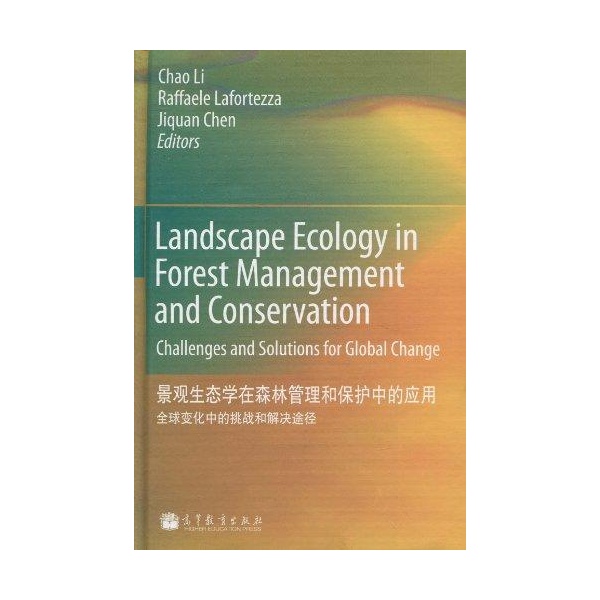《景觀生態學在森林管理和保護中的套用》是2010年高等教育出版社出版的圖書,作者是李超。
基本介紹
- 書名:景觀生態學在森林管理和保護中的套用
- 作者:李超
- ISBN:9787040291360
- 頁數:403
- 定價:69.00元
- 出版社:高等教育出版社
- 出版時間:2010-8
內容簡介
目錄
Chapter 1 Managing Forest Landscapes under Global Change Scenarios
1.1 Introduction
1.2 Forest management
1.3 New challenges in a changing globe
1.4 Landscape ecology contributions
1.5 Conclusion remarks
References
Chapter 2 Landscape Ecology Contributions to Forestry and Forest Management in China: Progresses and Research Needs
2.1 Introduction
2.2 China‘s forestry and forest management
2.3 Challenges and emerging global issues in forestry
2.4 Contributions of landscape ecology to forest management and conservation
2.5 Research needs for forest landscape management
2.6 Concluding remarks
Acknowledgements
References
Chapter 3 Issues Facing Forest Management in Canada, and Predictive Ecosystem Management Tools for Assessing Possible Futures
3.1 A brief history of forestry in Canada
3.2 Canada’s lands and forests
3.3 Issues facing forestry in Canada today
3.4 How can Canadian forestry respond to these and other issues?One way is ecosystem management modeling
3.5 Conclusions
References
Part Ⅱ Modeling Disturbance and Succession in Forest Landscapes
Chapter 4 Challenges and Needs in Fire Management: A Landscape Simulation Modeling Perspective
4.1 Introduction
4.2 Simulation modeling in fire management
4.3 Technical challenges in fire management modeling
4.4 A fire management simulation example
4.5 Research and management needs and solutions
4.6 Summary
References
Chapter 5 Using Landscape Disturbance and Succession Models to Support Forest Management
5.1 Introduction
5.2 Overview of landscape disturbance and succession models
5.3 Case studies
5.4 General conclusions
5.5 Future of LDSMs in decision-making
Acknowledgements
References
Chapter 6 Research Methods for Assessing the Impacts of Forest Disturbance on Hydrology at Large-scale Watersheds
6.1 Introduction
6.2 Definition of large-scale watersheds
6.3 Quantification of forest disturbance
6.4 Research methods on assessing impacts of forest disturbance on hydrology at large-scale watersheds
6.5 Future directions
6.6 Conclusions
Acknowledgements
References
Chapter 7 Software Applications to Three-Dimensional Visualization of Forest Landscapes —— A Case Study Demonstrating the Use of Visual Nature Studio (VNS) in Visualizing Fire Spread in Forest Landscapes
7.1 Introduction
7.2 Forest landscape visualization
7.3 Results and discussion
7.4 Conclusion
7.5 Future wildfire visualization research
Acknowledgements
References
Chapter 8 Predicting Tree Growth Dynamics of Boreal Forest in Response to Climate Change
8.1 Introduction
8.2 Materials and methods
8.3 Results
8.4 Discussion
8.5 Conclusions
Acknowledgements
References
Part III Emerging Approaches in Forest Landscape Conservation
Chapter 9 The Next Frontier: Projecting the Effectiveness of Broad-scale Forest Conservation Strategies
9.1 Introduction
9.2 Template project: Wild Rivers Legacy Forest and Two Hearted River Watershed
9.3 Conclusions and implications: Pushing the frontier
References
Chapter 10 Forest Avian Species Richness Distribution and Management Guidelines under Global Change in Mediterranean Landscapes
10.1 Introduction
10.2 Material and methods
10.3 Results and discussion
10.4 Concluding remarks and forest management guidelines
Acknowledgements
References
Chapter 11 Development of a Forest Network System to Improve the Zoning Process: A Case Study in Japan
11.1 Background of the Japanese forest policy and methodological problems
11.2 State of the public participation
11.3 How to improve the current zoning process
11.4 On the effective use of social backgrounds and evaluation
11.5 Experts vs. the general public
11.6 Perspectives of the future
References
Part Ⅳ Practicing Sustainable Forest Landscape Management
Index

